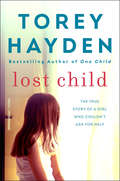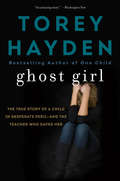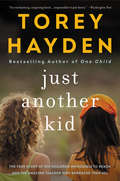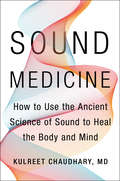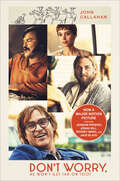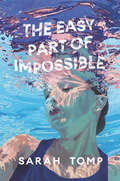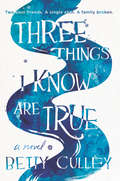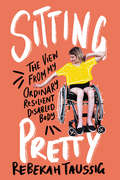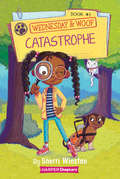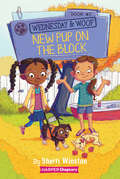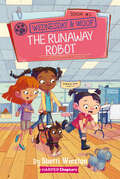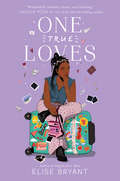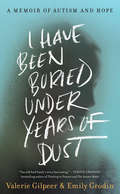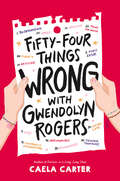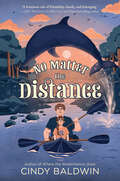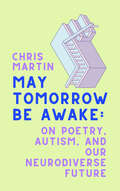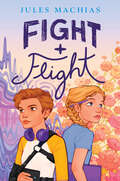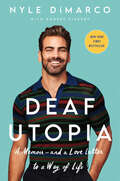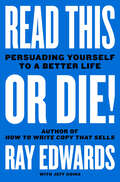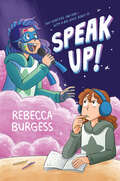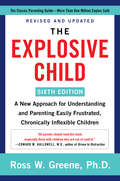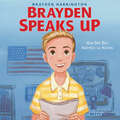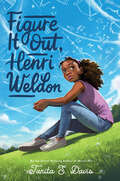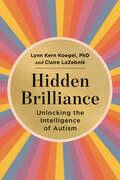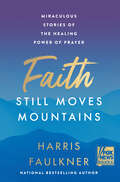- Table View
- List View
Lost Child: The True Story of a Girl Who Couldn't Ask for Help
by Torey HaydenThe first new book from beloved therapist and writer Torey Hayden in almost fifteen years—an inspiring, uplifting tale of a troubled child and the remarkable woman who made a difference.In a forgotten corner of Wales, a young girl languishes in a home for troubled children. Abandoned by her parents because of her violent streak, Jessie—at the age of ten—is at risk of becoming just another lost soul in the foster system. Precocious and bold, Jessie is convinced she is possessed by the devil and utterly unprepared for the arrival of therapist Torey Hayden. Armed with patience, compassion, and unconditional love, Hayden begins working with Jessie once a week. But when Jessie makes a stunning accusation against one of Hayden’s colleagues – a man Hayden implicitly trusts – Hayden’s work doubles: now she must not only get to the root of Jessie’s troubles, but also find out if what the girl alleges is true.A moving, compelling, and inspiring account, Lost Child is a powerful testament once again of Torey Hayden’s extraordinary ability to reach children who many have given up on—and a reminder of how patience and love can ultimately prevail.
Ghost Girl: The True Story Of A Child In Desperate Peril - And A Teacher Who Saved Her
by Torey HaydenJadie never spoke. She never laughed, or cried, or uttered any sound. Despite efforts to reach her, Jadie remained locked in her own troubled world . . . until one remarkable teacher persuaded her to break her self-imposed silence.Nothing in all of Torey Hayden’s experience could have prepared her for the shock of what Jadie told her—a story too horrendous for Torey’s professional colleagues to acknowledge. Yet a little girl was living in a nightmare, and Torey responded in the only way she knew how—with courage, compassion, and dedication—demonstrating once again the tremendous power of love and the resilience of the human spirit.
Just Another Kid: Each Was A Child No One Could Reach... Until One Amazing Teacher Embraced Them All
by Torey Hayden"Just Another Kid is not just another book. This remarkable teacher's memoir reminds us that love takes many forms." -The New York TimesFrom the bestselling author of One Child comes the true story of six children impossible to reach and the amazing teacher who embraced them all.Torey Hayden faced six emotionally troubled kids no other teacher could handle—three recent arrivals from battle-torn Northern Ireland, badly traumatized by the horrors of war; eleven-year-old Dirkie, who only knew of life inside an institution; excitable Mariana, aggressive and sexually precocious at the age of eight; and seven-year-old Leslie, perhaps the most hopeless of all, unresponsive and unable to speak.With compassion, rare insight, and masterful storytelling, teacher Torey Hayden once again touches our hearts with her account of the miracles that can happen in her class of “special” children.
Sound Medicine: How to Use the Ancient Science of Sound to Heal the Body and Mind
by Kulreet Chaudhary M.D.From a leading neurologist, neuroscientist and practitioner of Ayurvedic medicine, comes a rigorous scientific investigation of the healing power of sound, showing readers how they can use it to improve their mental and physical wellbeing. Why does a baby’s cry instantaneously flood a mother’s body with a myriad of stress hormones? How can a song on the radio stir up powerful emotions, from joy to anger, regret to desire? Why does sound itself evoke such primal and deeply felt emotions?A vibration that travels through air, water and solids, sound is produced by all matter, and is a fundamental part of every species’ survival. But there is a hidden power within sound that has only just begun to be investigated. Sound Medicine takes readers on a journey through the structure of the mouth, ears, and brain to understand how sound is translated from acoustic vibrations into meaningful neurological impulses. Renowned neurologist and Ayurvedic expert Dr. Kulreet Chaudhary explains how different types of sound impact the human body and brain uniquely, and explores the physiological effects of sound vibration, from altering mood to healing disease.Blending ancient wisdom with modern science, Dr. Chaudhary traces the history of sound therapy and the use of specific mantras from previously unknown texts—traced back to the Siddhas, a group of enlightened yogis who created a healing tradition that served as the precursor to Ayurvedic medicine—to explain the therapeutic application of sounds for a wide range of conditions. Sound Medicine offers practical, step-by-step lessons for using music and mantras, whether you’re a beginner or searching for a more advanced practice, to improve your health in body, mind, and spirit.
Don't Worry, He Won't Get Far on Foot
by John F. CallahanNow a major motion picture directed by Gus Van Sant and starring Joaquin Phoenix, Jonah Hill, and Rooney MaraFeaturing more than 60 of Callahan's original cartoons“When people laugh like hell and then say, ‘That’s not funny,’ you can be pretty sure they’re talking about John Callahan.”— P.J. O’RourkeIn 1972, at the age of 21, John Callahan was involved in a car crash that severed his spine and made him a quadriplegic. A heavy drinker since the age of 12 (alcohol had played a role in his crash), the accident could have been the beginning of a downward spiral. Instead, it sparked a personal transformation. After extensive physical therapy, he was eventually able to grasp a pen in his right hand and make rudimentary drawings. By 1978, Callahan had sworn off drinking for good, and begun to draw cartoons.Over the next three decades, until his death in 2010, Callahan would become one of the nation’s most beloved—and at times polarizing—cartoonists. His work, which shows off a wacky and sometimes warped sense of humor, pokes fun at social conventions and pushes boundaries. One cartoon features Christ at the cross with a thought bubble reading “T.G.I.F.” In another, three sheriffs on horseback approach an empty wheelchair in the desert. “Don’t worry,” one sheriff says to another, “He won’t get far on foot.”Don’t Worry, He Won’t Get Far on Foot recounts Callahan’s life story, from the harrowing to the hilarious. Featuring more than 60 of Callahan’s cartoons, it’s a compelling look at art, addiction, disability, and fame. A film adaptation scheduled for 2018, starring Joaquin Phoenix as John Callahan, will bring fresh attention to this underappreciated classic.
The Easy Part of Impossible
by Sarah TompAfter an injury forces Ria off the diving team, an unexpected friendship with Cotton, a guy on the autism spectrum, helps her come to terms with the abusive relationship she’s been in with her former coach.Ria Williams was an elite diver on track for the Olympics. As someone who struggled in school, largely due to her ADHD, diving was the one place Ria could shine.But while her parents were focused on the trophies, no one noticed how Coach Benny’s strict rules and punishments controlled every aspect of Ria’s life. The harder he was on her, the sharper her focus. The bigger the bruise, the better the dive.Until a freak accident at a meet changes everything. Just like that, Ria is handed back her life, free of Benny. To fill her now empty and aimless days, Ria rekindles a friendship with Cotton, a guy she used to know back in elementary school. With Cotton, she’s able to open up about what Benny would do to her, and through Cotton’s eyes, Ria is able to see it for what it was: abuse.Then Benny returns, offering Ria a second chance with a life-changing diving opportunity. But it’s not hers alone—Benny’s coaching comes with it. The thought of being back under his control seems impossible to bear, but so does walking away. How do you separate the impossible from possible when the one thing you love is so tangled up in the thing you fear most?
Three Things I Know Are True
by Betty CulleyFans of Jandy Nelson and Marieke Nijkamp will love this deeply moving novel in verse about the aftermath of a gun accident. <P><P>Life changes forever for Liv when her older brother, Jonah, accidentally shoots himself with his best friend Clay’s father’s gun. Now Jonah needs round-the-clock care just to stay alive, and Liv feels like she’s the only person who can see that her brother is still there inside his broken body. <P><P>With Liv’s mom suing Clay’s family, there are divisions in the community that Liv knows she’s not supposed to cross. But Clay is her friend, too, and she refuses to turn away from him—just like she refuses to give up on Jonah. <P><P>This powerful novel is a stunning exploration of tragedy, grief, compassion, and forgiveness.
Sitting Pretty: The View from My Ordinary Resilient Disabled Body
by Rebekah TaussigA memoir-in-essays from disability advocate and creator of the Instagram account @sitting_pretty Rebekah Taussig, processing a lifetime of memories to paint a beautiful, nuanced portrait of a body that looks and moves differently than most.Growing up as a paralyzed girl during the 90s and early 2000s, Rebekah Taussig only saw disability depicted as something monstrous (The Hunchback of Notre Dame), inspirational (Helen Keller), or angelic (Forrest Gump). None of this felt right; and as she got older, she longed for more stories that allowed disability to be complex and ordinary, uncomfortable and fine, painful and fulfilling.Writing about the rhythms and textures of what it means to live in a body that doesn’t fit, Rebekah reflects on everything from the complications of kindness and charity, living both independently and dependently, experiencing intimacy, and how the pervasiveness of ableism in our everyday media directly translates to everyday life. Disability affects all of us, directly or indirectly, at one point or another. By exploring this truth in poignant and lyrical essays, Taussig illustrates the need for more stories and more voices to understand the diversity of humanity. Sitting Pretty challenges us as a society to be patient and vigilant, practical and imaginative, kind and relentless, as we set to work to write an entirely different story.
Wednesday and Woof #1: Catastrophe (HarperChapters)
by Sherri WinstonCan Wednesday and her service dog, Woof, sniff out Mrs. Winter’s missing cat before her big trip? This is the first book of a fun full-color early chapter book series about the best detectives in the Midwest!Detective Tip #1 Try not to jump to conclusions. Wednesday and her service dog, Woof, are the best detectives in the whole world—or at least their neighborhood. But can they find Mrs. Winters’s missing cat before her big trip? Or will the case of the cat-napped kitty be their first unsolved mystery? HarperChapters build confident readers one chapter at a time! With short, fast-paced books, art on every page, and milestone markers at the end of every chapter, they're the perfect next step for fans of I Can Read!
Wednesday and Woof #2: New Pup on the Block (HarperChapters)
by Sherri WinstonCould a friend really have taken Wednesday’s brother’s prized possession? Wednesday and her service dog, Woof, take the case in the second book of this full-color early chapter book series about the best detectives in the Midwest!Detective Tip #2 Don’t forget to use your eyes, ears, and even your nose. Wednesday’s brother’s drone went missing in their own backyard. And that can mean only one thing—the thief is one of their friends! Can the neighborhood’s newest service dog help Wednesday and Woof sniff out the bandit? Or will the case of the missing drone be a doggone disaster?HarperChapters build confident readers one chapter at a time! With short, fast-paced books, art on every page, and milestone markers at the end of every chapter, they're the perfect next step for fans of I Can Read!
Wednesday and Woof #3: The Runaway Robot (HarperChapters)
by Sherri WinstonIt’s a double mystery when a robot and a hamster go missing before the science fair in the third book of this full-color early chapter book series about the best detectives in the Midwest!Detective Tip #3: Use your imagination and stay calm!When a classmate’s DIY robot goes missing right before the school Science Fair, Detective Wednesday Nadir and her service dog, Woof are sure they can find it…until the class hamster also disappears! Now the pressure is on! Can Wednesday and Woof use the scientific method to solve two cases at once—or will the stress cause a mess?HarperChapters build confident readers one chapter at a time! With short, fast-paced books, art on every page, and milestone markers at the end of every chapter, they're the perfect next step for fans of I Can Read!
One True Loves
by Elise BryantFrom the author of Happily Ever Afters comes another irresistible YA romantic comedy full of self-discovery and Black love—and a dreamy European cruise. Perfect for fans of Nicola Yoon, Jenny Han, and Stephanie Perkins, with crossover appeal for readers of Jasmine Guillory and Talia Hibbert romances.Lenore Bennett has always been a force. A star artist and style icon at her high school, she’s a master in the subtle art of not giving a . . . well, you know what. But now that graduation is here, she’s a little less sure.She’s heading to NYU in the fall with a scarlet U (for “undeclared”) written across her chest. Her parents always remind her that Black kids don’t have the luxury of figuring it out as they go—they have to be 110 percent prepared. But it’s a lot of pressure to be her ancestors’ wildest dreams when Lenore’s not even sure what her dreams are yet.When her family embarks on a post-graduation Mediterranean cruise, her friend Tessa is sure Lenore’s in for a whirlwind romance. But Lenore knows that doesn’t happen to girls like her.Then she meets Alex Lee. After their parents bond over the Cupid Shuffle, she ends up stuck with him for the remainder of the cruise. He’s a hopeless romantic and a golden boy with a ten-year plan. In short, he’s irritating as hell.But as they get to know each other during the picturesque stops across Europe, Alex may be able to help Lenore find something else she’s been looking for, even if she doesn’t want to admit it to herself: love.
I Have Been Buried Under Years of Dust: A Memoir of Autism and Hope
by Valerie Gilpeer Emily GrodinA remarkable memoir by a mother and her autistic daughter who’d long been unable to communicate—until a miraculous breakthrough revealed a young woman with a rich and creative interior life, a poet, who’d been trapped inside for more than two decades.“I have been buried under years of dust and now I have so much to say.”These were the first words twenty-five-year-old Emily Grodin ever wrote. Born with nonverbal autism, Emily’s only means of communicating for a quarter of a century had been only one-word responses or physical gestures. That Emily was intelligent had never been in question—from an early age she’d shown clear signs that she understood what was going on though she could not express herself. Her parents, Valerie and Tom, sought every therapy possible in the hope that Emily would one day be able to reveal herself. When this miraculous breakthrough occurred, Emily was finally able to give insight into the life, frustrations, and joys of a person with autism. She could tell her parents what her younger years had been like and reveal all the emotions and intelligence residing within her; she became their guide into the autistic experience.Told by Valerie, with insights and stories and poetry from Emily, I Have Been Buried Under Years of Dust highlights key moments of Emily’s childhood that led to her communication awakening—and how her ability rapidly accelerated after she wrote that first sentence. As Valerie tells her family’s story, she shares the knowledge she’s gained from working as a legal advocate for families affected by autism and other neurological disorders. A story of unconditional love, faith in the face of difficulty, and the grace of perseverance and acceptance, I Have Been Buried Under Years of Dust is an evocative and affecting mother-daughter memoir of learning to see each other for who they are.
Fifty-Four Things Wrong with Gwendolyn Rogers
by Caela CarterFrom the critically acclaimed author of the ALA Notable and Charlotte Huck Honor Book Forever, or a Long, Long Time comes a moving own-voices story that shines a light on how one girl’s learning differences are neither right nor wrong…just perfectly individual. For fans of Alyson Gerber, Cammie McGovern, and Kathryn Erskine. <p><p> No one can figure out what Gwendolyn Rogers’s problem is—not her mom, or her teachers, or any of the many therapists she’s seen. But Gwendolyn knows she doesn’t have just one thing wrong with her: she has fifty-four. <p><p> At least, according to a confidential school report (that she read because she is #16. Sneaky, not to mention #13. Impulsive). So Gwendolyn needs a plan, because if she doesn’t get these fifty-four things under control, she’s not going to be able to go to horse camp this summer with her half-brother, Tyler. <p><p> But Tyler can’t help her because there’s only one thing “wrong” with him: ADHD. And her best friend Hettie can’t help her because there’s nothing wrong with Hettie. She’s perfect. So Gwendolyn is hopeless until she remembers the one thing that helped her mother when her own life was out of control. Or actually, the twelve things. <p><p> Can these Twelve Steps that cured her mother somehow cure Gwendolyn too?
No Matter the Distance
by Cindy BaldwinAn unexpected animal companion helps a girl with cystic fibrosis learn to write her own story in this captivating novel in verse by award-winning author and disabled activist Cindy Baldwin. Penny Rooney has cystic fibrosis, which means she has to do breathing treatments to help her lungs work. Some days, it seems like her CF is the only thing Penny knows about herself for sure.From her point of view, everyone around her can make sense of their place in the world. So why can’t Penny even begin to write a poem about herself for school?Then during spring break Penny spots something impossible in the creek behind her house: a dolphin, far from its home. Penny names the dolphin Rose and feels an immediate bond, since the dolphin is also sick.But as Penny’s CF worsens, she realizes that Rose needs to return to her pod to get better. Will Penny be able to help guide Rose back to the ocean, even if it means losing her friend?This heartwarming story, which marks the first time an author with cystic fibrosis is writing a protagonist with CF, will transport readers into a world full of friendship, family, and powerful self-discovery.
May Tomorrow Be Awake: On Poetry, Autism, and Our Neurodiverse Future
by Chris MartinAn author and educator’s pioneering approach to helping autistic students find their voices through poetry—a powerful and uplifting story that shows us how to better communicate with people on the spectrum and explores how we use language to express our seemingly limitless interior lives.Adults often find it difficult to communicate with autistic students and try to “fix” them. But what if we found a way to help these kids use their natural gifts to convey their thoughts and feelings? What if the traditional structure of language prevents them from communicating the full depth of their experiences? What if the most effective and most immediate way for people on the spectrum to express themselves is through verse, which mirrors their sensory-rich experiences and patterned thoughts?May Tomorrow Be Awake explores these questions and opens our eyes to a world of possibility. It is the inspiring story of one educator’s journey to understand and communicate with his students—and the profound lessons he learned. Chris Martin, an award-winning poet and celebrated educator, works with non-verbal children and adults on the spectrum, teaching them to write poetry. The results have been nothing short of staggering for both these students and their teacher. Through his student’s breathtaking poems, Martin discovered what it means to be fully human.Martin introduces the techniques he uses in the classroom and celebrates an inspiring group of young autistic thinkers—Mark, Christophe, Zach, and Wallace—and their electric verse, which is as artistically dazzling as it is stereotype-shattering. In telling each of their stories, Martin illuminates the diverse range of autism and illustrates how each so-called “deficit” can be transformed into an asset when writing poems. Meeting these remarkable students offers new insight into disability advocacy and reaffirms the depth of our shared humanity. Martin is a teacher and a lifelong learner, May Tomorrow Be Awake is written from a desire to teach and to learn—about the mind, about language, about human potential—and the lessons we have to share with one other.
Fight + Flight
by Jules MachiasJules Machias, author of Indie Next List Pick Both Can Be True, delivers another inspiring story about how an unexpected friendship transforms the lives of two middle schoolers.Avery Hart lives for the thrill and speed of her dirt bike and the pounding thump of her drum kit. But after she’s diagnosed with hypermobile Ehlers-Danlos syndrome, a disease that affects her joints, Avery splits her time between endless physical therapy and worrying that her fun and independence are over for good.Sarah Bell is familiar with worry, too. For months, she’s been having intense panic attacks. No matter how much she pours her anxiety into making art, she can’t seem to get a grip on it, and she’s starting to wonder if she’ll be this way forever.Just as both girls are reaching peak fear about what their futures hold, their present takes a terrifying turn when their school is seemingly attacked by gunmen. Though they later learn it was an active shooter drill, the traumatic experience bonds the girls together in a friendship that will change the way they view their perceived weaknesses—and help them find strength, and more, in each other.
Deaf Utopia: A Memoir—and a Love Letter to a Way of Life
by Nyle DiMarco Robert SiebertA heartfelt and inspiring memoir and celebration of Deaf culture by Nyle DiMarco, actor, producer, two-time reality show winner, and cultural icon of the international Deaf communityBefore becoming the actor, producer, advocate, and model that people know today, Nyle DiMarco was half of a pair of Deaf twins born to a multi-generational Deaf family in Queens, New York. At the hospital one day after he was born, Nyle “failed” his first test—a hearing test—to the joy and excitement of his parents.In this engrossing memoir, Nyle shares stories, both heartbreaking and humorous, of what it means to navigate a world built for hearing people. From growing up in a rough-and-tumble childhood in Queens with his big and loving Italian-American family to where he is now, Nyle has always been driven to explore beyond the boundaries given him. A college math major and athlete at Gallaudet—the famed university for the Deaf in Washington, DC—Nyle was drawn as a young man to acting, and dove headfirst into the reality show competitions America’s Next Top Model and Dancing with the Stars—ultimately winning both competitions.Deaf Utopia is more than a memoir, it is a cultural anthem—a proud and defiant song of Deaf culture and a love letter to American Sign Language, Nyle’s primary language. Through his stories and those of his Deaf brothers, parents, and grandparents, Nyle opens many windows into the Deaf experience.Deaf Utopia is intimate, suspenseful, hilarious, eye-opening, and smart—both a memoir and a celebration of what makes Deaf culture unique and beautiful.
Read This or Die!: Persuading Yourself to a Better Life
by Jeff Goins Ray EdwardsDiagnosed with a terminal illness, a leading marketing consultant discovers that what he has learned about persuading others might help him save his own life. Ray Edwards was one of the top marketers and copywriters in the business with A-list clients like Tony Robbins, Jack Canfield, and Michael Hyatt when he was diagnosed with Parkinson’s. The diagnosis brought his life to a screeching halt and propelled Edwards to question everything he thought he knew about his Christian faith, his relationships, what kind of person he was, and how the world worked.Out of options and deeply depressed, Edwards decided he needed to turn his life around or die a failure. He had to let go of false beliefs and find better ones. To his surprise, he found that the principles of persuasion he’d honed for over four decades to move others could work for him. In the vein of The Last Lecture and Tuesdays with Morrie, Read This or Die! Is the tale of one man’s transformation and how he achieved it.Edwards outlines the powerful, time-tested PASTOR process he created that helped him identify and untangle the beliefs that were holding him back and provided a game plan for how to change his life:Pain: start with what hurtsAmplify: determine how it will get worse before it gets betterStory: find the story of a better futureTransformation: choose the evidence worth believingOpportunity: discern where change can happenResponse: set up a system that makes transformation stickFor anyone who wants to turn their life around but does not know how, the PASTOR method teaches how to harness marketing wisdom to get honest about what we really want from life and craft better beliefs and plans to help us start living life on our own terms.
Speak Up!
by Rebecca BurgessFor fans of Click and Brave, this touching coming-of-age middle grade graphic novel debut follows an autistic girl who finds friendship where she least expects it and learns to express her true self in a world where everyone defines her by her differences.Twelve-year-old Mia is just trying to navigate a world that doesn’t understand her true autistic self. While she wishes she could stand up to her bullies, she’s always been able to express her feelings through singing and songwriting, even more so with her best friend, Charlie, who is nonbinary, putting together the best beats for her.Together, they've taken the internet by storm; little do Mia’s classmates know that she’s the viral singer Elle-Q! But while the chance to perform live for a local talent show has Charlie excited, Mia isn’t so sure.She’ll have to decide whether she’ll let her worries about what other people think get in the way of not only her friendship with Charlie, but also showing everyone, including the bullies, who she is and what she has to say.
The Explosive Child [Sixth Edition]: A New Approach for Understanding and Parenting Easily Frustrated, Chronically Inflexible Children
by Ross W Greene PhDNow in a revised and updated 6th edition, the groundbreaking, research-based approach to understanding and parenting children who frequently exhibit severe fits of temper and other challenging behaviors, from a distinguished clinician and pioneer in the field.What’s an explosive child? A child who responds to routine problems with extreme frustration—crying, screaming, swearing, kicking, hitting, biting, spitting, destroying property, and worse. A child whose frequent, severe outbursts leave his or her parents feeling frustrated, scared, worried, and desperate for help. Most of these parents have tried everything-reasoning, explaining, punishing, sticker charts, therapy, medication—but to no avail. They can’t figure out why their child acts the way he or she does; they wonder why the strategies that work for other kids don’t work for theirs; and they don’t know what to do instead.Dr. Ross Greene, a distinguished clinician and pioneer in the treatment of kids with social, emotional, and behavioral challenges, has worked with thousands of explosive children, and he has good news: these kids aren’t attention-seeking, manipulative, or unmotivated, and their parents aren’t passive, permissive pushovers. Rather, explosive kids are lacking some crucial skills in the domains of flexibility/adaptability, frustration tolerance, and problem solving, and they require a different approach to parenting. Throughout this compassionate, insightful, and practical book, Dr. Greene provides a new conceptual framework for understanding their difficulties, based on research in the neurosciences. He explains why traditional parenting and treatment often don’t work with these children, and he describes what to do instead. Instead of relying on rewarding and punishing, Dr. Greene’s Collaborative Problem Solving model promotes working with explosive children to solve the problems that precipitate explosive episodes, and teaching these kids the skills they lack.
Brayden Speaks Up: How One Boy Inspired the Nation
by Brayden HarringtonBrayden Harrington, a thirteen-year-old boy who stutters, gives an incredible speech that electrifies the nation in this timely and extraordinary nonfiction picture book that celebrates the importance of speaking up and using your voice—for everyone deserves to be heard. When Brayden talks, his words get caught in his mouth. He has bumpy speech—and that’s okay! Sometimes, though, he doesn’t feel anyone really understands what it feels like to be a person who stutters.Then Brayden meets Joe Biden, who knows exactly how he feels and inspires him to be more confident. But when Mr. Biden asks Brayden to give a big speech in front of the whole nation, will Brayden be brave enough to speak up and speak out? Brayden Speaks Up is the incredible true story of one extraordinary boy’s perseverance and the importance of celebrating yourself just as you are. For after all, your biggest challenge just might be your greatest gift.
Figure It Out, Henri Weldon
by Tanita S. DavisTanita S. Davis, author of Partly Cloudy and Serena Says, has written another funny, warm story featuring middle school and family life—all about the complex calculations it takes for everyone to balance the equations of their lives and what it takes to be part of a team while handling a learning disability. This middle grade novel is perfect for fans of From the Desk of Zoe Washington and A Good Kind of Trouble.Seventh grader Henrietta Weldon gets to switch schools—finally! She’ll be “mainstreaming” into public school, leaving her special education school behind. She can’t wait for her new schedule, new friends, and new classes.Henri’s dyscalculia, a learning disability that makes math challenging to process and understand, is what she expects to give her problems. What she doesn’t expect is a family feud with her sister over her new friends, joining the girls’ soccer team, and discovering poetry. Henri’s tutor and new friend, Vinnie, reminds her to take it slow. One problem at a time.If Henri Weldon has twenty-four hours in a day, and she has two siblings who dislike her four new friends, two hours of soccer practice, seven hours of classes, and three hours of homework . . . she has:A. No free timeB. No idea how to make everyone happyC. No time to figure it out, Henri Weldon!
Hidden Brilliance: Unlocking the Intelligence of Autism
by Lynn Kern Koegel Claire LaZebnikA groundbreaking exploration of the ways in which the intelligence and abilities of children and young adults with autism are often overlooked and misjudged, with tried-and-true interventions that can be used to help them reach their full potential.Our limited and often biased view of what’s considered “normal” often prevents us from recognizing the gifts and brilliance of those who don’t fit a specific mold. Too often we don’t explore and take advantage of the far-reaching gifts and potential of those diagnosed as being on the autism spectrum or neurodiverse. Dr. Lynn Kern Koegel has had vast experience researching Autism Spectrum Disorders—ASD—and working with autistic people of all ages. She has repeatedly witnessed firsthand evidence of great intelligence that hasn’t yet been nurtured or realized.In Hidden Brilliance, Dr. Koegel and writer Claire LaZebnik explore the ways in which the brilliance and talents of children and young adults diagnosed with ASD are commonly overlooked or misjudged, even by trained professionals. This book isn’t about changing people, but about bringing out their best, by focusing on and nurturing their strengths. The authors examine the forces at play—including outdated attitudes, a lack of sufficient training, and an overreliance on standardized testing--that complicate and confuse the effort to see the remarkable capabilities of these kids. The authors argue that behaviors often described as disruptive or interfering are actually brilliant attempts at communication and point the reader toward interventions that can encourage people to effectively communicate their needs and thoughts. Hidden Brilliance helps us see how and why parents—who often feel alone in their ability to see past their children’s struggles to the incredible capabilities underneath —are often dismissed or ignored.This long overdue book explains ways to identify your child’s strengths and abilities and then use them as a tool for social communication, improved learning, and overall growth. While no one can predict a child’s future, a positive and supportive attitude combined with the right goals and interventions that consider the child’s strengths can lead to extraordinary growth and connection. Warm and hopeful, Hidden Brilliance opens the door to a new way of looking at people diagnosed with ASD—those who deserve to have their brilliance shine brightly for all to see.
Faith Still Moves Mountains: Miraculous Stories of the Healing Power of Prayer
by Harris FaulknerFrom FOX News anchor and author Harris Faulkner comes a collection of powerful, true-life stories of resilience, healing, rescue, and protection.We need reminders of God’s power now more than ever.We often think about prayer as a wish list, with God as Santa Claus. The reality is that the power of prayer reminds us not only how small we are, but also how big God is. Prayer is hope put into action. And prayer works.From the aftermath of the devastating earthquake in Haiti to the theater shooting in Aurora, Colorado, believers testify to how God inspired hope even when all seemed lost.Two teenagers who were saved from treacherous seas by a vessel named Amen now give thanks for the rescue that changed their lives. A woman’s near-death experience with COVID-19 turned out to be the crisis freeing her from despair. Others speak to how prayer helped them navigate family trauma, overcome abuse, and cope with mental illness and depression. Historical accounts of miracles testify to God’s power throughout time, and Faulkner recounts the role of faith and prayer in her own life and the life of her father.Along with these stories of God’s presence, the book includes an exclusive packet of newly written prayers. Created to reflect the current times, this prayer booklet will provide a road map for putting the lessons of these stories into action.Faith Still Moves Mountains reminds us that God’s light always shines through the darkness. Through these testimonies, we learn prayer isn’t just a ritual, it’s a vital spiritual strategy in a world that wants us to give up the fight.
